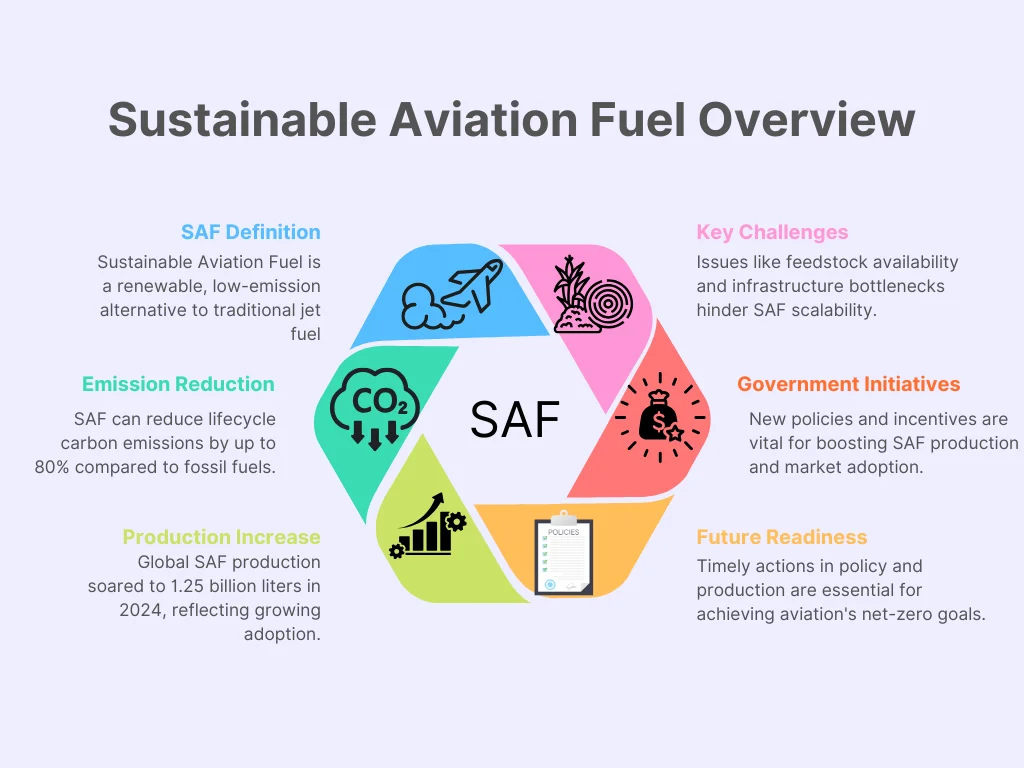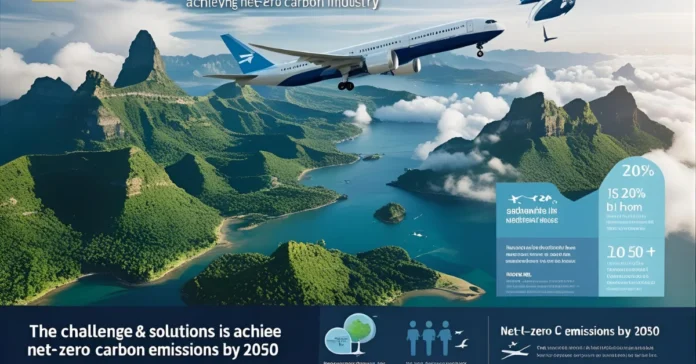The International Air Transport Association (IATA) speaks for about 350 airlines worldwide, and it is raising an urgent alarm: the aviation industry needs to act fast if we want to achieve net-zero carbon emissions by 2050.
A crucial part of this plan involves increasing the use of Sustainable Aviation Fuel (SAF). SAF is a type of jet fuel that has a significantly lower carbon footprint compared to traditional jet fuels.
To make this shift possible, governments worldwide must create clear and strategic policies that support the scaling up of SAF production and use.
By doing so, the aviation industry can reduce its impact on climate change and help create a cleaner, healthier planet for future generations.
What is SAF & Why It Matters
Definition & Emissions Reduction
Sustainable Aviation Fuel (SAF) is a special type of jet fuel made from renewable resources. Unlike conventional jet fuel, which comes from fossil fuels, SAF can be produced from various renewable materials such as leftover cooking oils, agricultural waste, and even municipal trash.
Additionally, advanced methods allow SAF to be synthesized using green hydrogen and captured carbon dioxide (CO₂).
One of the main advantages of SAF is its ability to cut lifecycle carbon emissions by up to 80% compared to regular jet fuel.
This means that for every liter of SAF used, significantly less carbon dioxide is released into the atmosphere, making air travel much less harmful to the environment.
Historic Uptake
The adoption of SAF has been slow but is gradually increasing. In 2023, the global production of SAF reached 600 million liters, which is only about 0.2% of the total aviation fuel used.
In 2024, production doubled to 1 million tonnes (approximately 1.25 billion liters, or 0.3% of aviation fuel).
Experts predict that by 2025, production will rise even further to around 2 million tonnes (about 2.5 billion liters, or 0.7%). Although these numbers show progress, they highlight the urgency of ramping up SAF production to meet future demands.
Scaling vs. Costs
Sky-high Costs
Although SAF is a promising solution, it currently costs much more than traditional fossil jet fuel. IATA estimates that if the production of SAF doubles to 2 million tonnes in 2025, it will add an extra $4.4 billion to the global fuel bills for airlines.
This high cost is a significant barrier to wider adoption, and it underscores the need for policy support to make SAF more financially viable for airlines.
Policy Gaps
Current policies that aim to boost SAF usage, such as the European Union’s SAF mandate (which requires a minimum of 2% SAF by 2025 and 6% by 2030), are viewed as “unrealistic” by many airlines.
This is due to the limited supply of SAF and the high costs associated with production. IATA’s Director General, Willie Walsh, has pointed out potential issues with fragmented tax proposals and inefficiencies in how these policies are structured.
To effectively scale up SAF production, it is crucial for governments to create well-coordinated and practical policies.
Global Policy Landscape
Mandates & Tax Credits
In the United States, there are financial incentives like the 45Z tax credit for clean fuels. However, this credit does not account for indirect land-use emissions, which may limit its effectiveness.
Similarly, global initiatives such as the International Civil Aviation Organization’s (ICAO) Carbon Offsetting and Reduction Scheme (CORSIA) depend on Sustainable Aviation Fuel, but the availability of carbon credits worldwide is often patchy and inconsistent.
IATA’s Demands
To foster a more sustainable aviation industry, IATA is calling for:
- Harmonized, Technology-Neutral SAF Mandates: Policies that support all types of SAF and do not favor one technology over another.
- Financial Incentives: More tax credits and grants to encourage investment in SAF technology.
- Knowledge and Tech Transfer: Assistance for low-income countries to develop their own SAF production capabilities.

Challenges Beyond Policy
Feedstock Availability
One of the key challenges is the availability of feedstock for Sustainable Aviation Fuel production. There is competition for the same renewable resources from other sectors like food and energy production, which can limit the supply of materials needed for SAF.
Infrastructure Bottlenecks
Another hurdle is the current infrastructure for producing and distributing SAF. Existing refinery capacities and logistical networks are not yet prepared to meet the increasing demand for SAF.
Manufacturer Hesitancy
Major aircraft manufacturers like Boeing and Airbus have been slow to deliver new, fuel-efficient aircraft that can use SAF, which further complicates the transition to sustainable aviation.
Market Readiness
While some airlines, like United Airlines, International Airlines Group (IAG), and Norwegian, are negotiating agreements with Sustainable Aviation Fuel producers like Norsk Fuels, the actual uptake of SAF remains limited. For a wider impact, more airlines need to commit to using SAF.
Solutions Underway
Mandates in Action
The EU and UK have already implemented SAF mandates, which took effect in 2025. The ICAO has set a global framework that aims for a 5% reduction in carbon intensity by 2030.
Incentive Frameworks
Governments are creating various frameworks to encourage Sustainable Aviation Fuel production, including tax credits, blending mandates, government grants, and carbon pricing.
Industrial Investment
There’s a growing trend of partnerships between airlines and SAF producers. For instance, Norwegian’s investment in Norsk Fuels is expected to yield 250 million liters of e-fuel by 2030, indicating that airlines are starting to take tangible steps toward incorporating SAF into their operations.
The Road Ahead

IATA has issued a stark warning: failing to meet Sustainable Aviation Fuel supply targets and aligning policies today could jeopardize the transition to net-zero aviation.
It’s crucial for airlines to invest in sustainable practices, for manufacturers to deliver efficient aircraft, and for governments to enact supportive legislation.
As Willie Walsh aptly stated, “The pace of progress … must accelerate.” The future of air travel depends on closing the gap between policy and production. Without this crucial step, Sustainable Aviation Fuel could remain a niche solution, insufficient to significantly reduce aviation’s carbon emissions and combat climate change.
FAQs About Sustainable Aviation Fuel (SAF)
- What exactly is Sustainable Aviation Fuel (SAF)?
- SAF is a renewable jet fuel made from sustainable feedstocks like waste oils, agricultural residues, and green hydrogen. It aims to reduce carbon emissions from aviation.
- How much can SAF reduce carbon emissions?
- SAF can lower lifecycle carbon emissions by up to 80% compared to traditional fossil jet fuel.
- Why is SAF currently so expensive?
- Production costs for SAF are high due to limited supply, the complexity of production processes, and competition for feedstock.
- How is the government supporting SAF adoption?
- Governments are introducing tax credits, blending mandates, and grants to encourage the development and use of SAF, but policies need to align better with market needs.
- What are the challenges ahead for SAF adoption?
- Major challenges include feedstock availability, the need for better infrastructure, manufacturer hesitancy to produce new efficient planes, and limited market readiness among airlines.
Recent Developments in SAF
In June 2025, the European Union announced new initiatives aimed at increasing SAF production and use within its member states.
These initiatives include funding support for innovative SAF technologies and a commitment to enhance infrastructure for SAF distribution.
This move reflects a broader strategy to achieve significantly lower aviation emissions and support the transition to sustainable air travel.
This complete guide aims to clarify the urgent need for stronger SAF policies and the steps required to make aviation more sustainable.
Also Read:
IATA Releases SAF Matchmaker: Connecting Airlines and SAF Suppliers to Boost Aviation Sustainability

